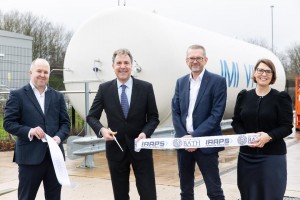The West of England’s first green hydrogen production and storage plant has been officially opened, underpining the region’s status as a leader in research into what is widely regarded as the fuel of the future.
The plant, at the state-of-the-art Institute for Advanced Automotive Propulsion Systems (IAAPS) on the Bristol and Bath Science Park, will be used to carry out research on how to use green hydrogen in sectors such as aviation, shipping and heavy-duty transport.
A key area of the work will focus on hydrogen (H2) storage, with the plant including a facility to cool the gas to below minus 250C.
Finding a practical method of storing hydrogen is seen as key to making it a viable alternative to fossil fuels, especially in hard-to-decarbonise sectors.
The plant will also make the IAAPS fully self-sufficient for energy. The £70m centre opened last September to develop clean, sustainable and affordable technologies and support the transport industry in the transition to net zero.
The plant will produce and store green hydrogen, which is made by removing the oxygen in water through electrolysis powered by renewable sources such as wind, water or solar.
It is increasingly being viewed as a viable source of clean energy, particularly in heavy-use sectors such as freight transport and distribution and possibly also mass passenger transport.
However, green hydrogen currently accounts for just 1% of all hydrogen produced globally.
Most is ‘grey’ hydrogen, which is made through fossil fuel-powered electrolysis, making it far less environmentally friendly.
The hydrogen production and storage plant at IAAPS was officially opened by Metro Mayor Dan Norris, pictured, above second left, who leads the West of England Combined Authority (WECA), which has invested £2.5m in the project.
He said: “Green hydrogen is one really important solution to the world’s climate problems – it’s powerful and there’s lots of it.
“The potential when it comes to slashing emissions in those hard-to-decarbonise sectors like transport, and others, is huge.
“That’s why I’m pleased to open the region’s first ever green hydrogen plant, which could really help lead to green hydrogen being much more widely used globally.
“It just goes to show how our West of England region really is becoming a zero-emission and innovation leader.”
IAAPS executive director Prof Chris Brace, who cut the ceremonial ribbon alongside the mayor, added: “Green hydrogen represents a pivotal shift towards a more sustainable and environmentally responsible energy landscape, offering immense potential as a clean alternative to traditional fossil fuels.
“At IAAPS, we recognise the transformative power of H2 technologies, in particular for the hard to electrify sectors of the mobility industry.
“Our new hydrogen production plant, in tandem with our cutting edge H2 research facilities, provides us and our partners with the tools that we need to accelerate this transition.
“It’s not only a regional beacon, but also a national asset, crucial in driving forward sustainable research & innovation and actively addressing the challenges of climate change.”
The IAAPS green hydrogen production and storage plant is the latest in a string of initiatives positioning the West of England as the UK’s hydrogen powerhouse.
Last October the multi-million pound The Great Western Supercluster of Hydrogen Impact for Future Technologies (GW-SHIFT) was launched, bringing together academic, civic and industry leaders to unlock the huge potential of the region’s hydrogen ecosystem.
Over the next four years, GW-SHIFT, which is co-led by the University of Bath and includes the University of Bristol, will support innovative research and activities to create a thriving low carbon hydrogen supercluster in the region.
Experts predict harnessing clean green hydrogen to decarbonise the region’s transport, energy and storage & distribution sectors could support up to 100,000 jobs by 2050.






























